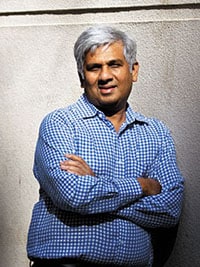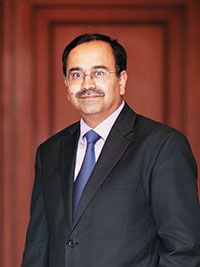
CPSE ETF: Whose idea was it?
We emailed five questions to Sanjiv Shah, co-CEO of Goldman Sachs India AMCs (GSAM), and Anup Bagchi, MD and CEO of ICICI Securities about the CPSE ETF. Here's what they had to say
1. How did the idea of a PSE ETF come along? Sanjiv Shah: GSAM started having conversations with the government and Department of Disinvestment around February 2012 to suggest alternative approaches to undertake disinvestment. We wanted to look at how participation by a large number of investors could be encouraged as well as how to leverage the prevalent nationwide stock exchange network. Given our expertise in Exchange Traded Funds (ETFs), GSAM proposed that an ETF could be an elegant solution for disinvestment, providing a low-cost, transparent, rules-based, diversified vehicle that could be used by a wide variety of investors. This effectively became the genesis of the PSE ETF concept.
Sanjiv Shah: GSAM started having conversations with the government and Department of Disinvestment around February 2012 to suggest alternative approaches to undertake disinvestment. We wanted to look at how participation by a large number of investors could be encouraged as well as how to leverage the prevalent nationwide stock exchange network. Given our expertise in Exchange Traded Funds (ETFs), GSAM proposed that an ETF could be an elegant solution for disinvestment, providing a low-cost, transparent, rules-based, diversified vehicle that could be used by a wide variety of investors. This effectively became the genesis of the PSE ETF concept.
 Anup Bagchi: Prior to ETF, government disinvestment happened either through FPO, which was a more time consuming process and at higher cost, or later through OFS. It was observed that there was an immediate pressure on price the moment a disinvestment was announced. This also meant disinvestments only in individual companies, and hence it was difficult to prioritise and reach a larger target.
Anup Bagchi: Prior to ETF, government disinvestment happened either through FPO, which was a more time consuming process and at higher cost, or later through OFS. It was observed that there was an immediate pressure on price the moment a disinvestment was announced. This also meant disinvestments only in individual companies, and hence it was difficult to prioritise and reach a larger target.
The Central Public Sector Enterprise (CPSE) ETF is the innovative disinvestment strategy that helped the government garner Rs 3,000 crore through disinvestment of 10 PSUs, and it provides an opportunity for investors to become part-owners of Oil & Natural Gas Corp, GAIL India, Coal India, Indian Oil, Oil India, Power Finance Corp, Rural Electrification Corp, Container Corp, Engineers India and Bharat Electronics. We observed that there was no pressure on the price of individual stocks during the process.
The CPSE ETF is a one-of-its-kind disinvestment strategy used in the world.
2. How did you convince the department of investment to work on the idea?
Sanjiv Shah: Convincing the government was a multi-step process wherein each concept needed to be backed by concrete data as well as best practices from other markets. For example, initially, we worked closely with the government to articulate the advantages of ETFs, especially with regard to low costs, transparency and low tracking errors. Subsequently, we were able to convince the government that the conditions in India were now right for rapid growth of ETFs, similar to the phenomenal growth witnessed in developed markets in the past decade. Finally, we were able to convince the government that GSAM has the ability to successfully execute a programme of such scale and complexity, having in-depth product knowledge as well as a strong, diversified domestic and global client franchise.
Anup Bagchi: The Department of Disinvestment wanted to evaluate the idea of an ETF further and for this they announced an RFP for advisor.
ICICI Securities applied for the role of advisor. Based on technical understanding of the market and the product, as well as competitive fee structure, the government awarded us the mandate to advise them on the course to be taken in floating an exchange traded fund of public sector undertaking.
Once we were appointed as an advisor, we conducted a feasibility study. As part of the study we covered global as well as Indian markets, we spoke with various intermediaries to get their views and came up with our feasibility report. In this report we not only covered the market potential but also the enabling environment that needs to be created for ETFs. The report was presented to the IMG and was accepted. We also presented the benefit that such an ETF could bring by opening a channel for disinvestment that can be tapped on a continuous basis without market disruption and with minimal cost impact. We were then asked to work on phase 2, ie to take this concept to execution.
3. What were the creative challenges in designing and creating the ETF? How long did it take from conception to execution?
Sanjiv Shah: There were multiple creative challenges in designing the ETF, from ensuring that the product could be used by both institutional and retail investors, to building various innovations like loyalty units to attract long-term investors. Also, a lot of thought went into ensuring that the ETF can be used as an ongoing, daily mechanism for disinvestment using a ‘tap structure’, and thereby avoid timing and stock-specific risks that are usually associated with disinvestment transactions.
Anup Bagchi: ETF as a product category, though very big globally, has still to pick up in India. Until now, a large asset under ETF was for Gold ETF. Hence, the challenge was not just in designing a good product but also to ensure that the market understood and accepted this product.
The design of the product kept in mind the objective of creating a good product for the investor while balancing the government objectives of lower cost and minimal market disruption. Additionally, the design also gave the government the flexibility for continuous disinvestment over a period of time.
During our journey of the past 18 months, we got tremendous support from the government, the regulators and stock exchanges. ETFs used to have a double impact of STT, this anomaly was corrected. IRDA also came out with investment guidelines on ETFs making them part of the approved investment. Since this product was unique—the underlying shares of the NFO were to come from the government and there were discounts involved—Sebi was also very open, and many consultations with them helped in getting the final design for this product. The National Stock Exchange also worked in popularising the category.
The AMC was appointed through a competitive bidding process, and Goldman Sachs AMC was the selected AMC. The AMC also worked very closely on getting the finer points and taking this to execution.
The CPSE ETF offers investors an upfront discount of 5 percent to all investors and additional loyalty units to retail investors who hold on to the units for one year (1 for every 15 units held). In addition, the basket is high quality PSE stocks that are high on dividend yield. The historical yields have been in excess of 3.5 percent. This entire proposition along, with the low cost structure of 0.49 percent, made the product attractive and it garnered interest from all kinds of investors, domestic institutions, corporates and bank treasuries, retail investors, HNIs and FIIs.
4. Was there a bidding process for the advisor and AMC? What were the criteria and why did u qualify?
Sanjiv Shah: There was a bidding process comprising financial as well as technical criteria for the appointment of the advisor as well as the AMC. GSAM won the bid by quoting the minimum expense ratio of 0.49 percent for assets up to Rs 5,000 crore, as well as obtaining the highest points in the technical evaluation. In the technical criteria, several parameters were considered, including GSAM’s experience in managing ETFs in India, superior stock exchange liquidity / lower tracking errors of our ETFs as well as a proven track record in successfully developing new concepts like the Gold ETF.
Anup Bagchi: This has been explained in Q1.
5. What is your view on ETFs and your experience in working with ETFs in India?
Sanjiv Shah: Our view is that ETFs are now poised for rapid growth in India, similar to the experience of developed markets in the past decade. This takes place as investors get introduced to ETFs, they realise some of their key advantages including low costs, low tracking errors as well as the ability to access diverse asset classes. Essentially, ETFs are an extremely attractive proposition because they provide the convenience of stocks as well as the diversification inherent in a mutual fund.
Anup Bagchi: Globally, ETFs are used by retail investors as well as institutional investors. For the retail investor the ETF provides a great opportunity to invest in a basket of lower ticket size and with a much lower cost as compared to a mutual fund. For the institutional investor it helps the fund managers focus on more strategic decisions to create alpha while the beta gets tracked with a significant exposure to an ETF based on the underlying index.
In India, this category is still growing and has distinct advantages over mutual funds as well as over individual stocks. As the markets get more mature and investment advisory picks up, we will see individual investors investing in ETFs to align their portfolio exposure as this brings in exposure to the asset class at a very low cost. We also expect institutional investors to move towards ETFs as this will be cost-effective in tracking the underlying index and the fund manager can focus on generating alpha.
Photographs: Prasad Gori for Forbes India














